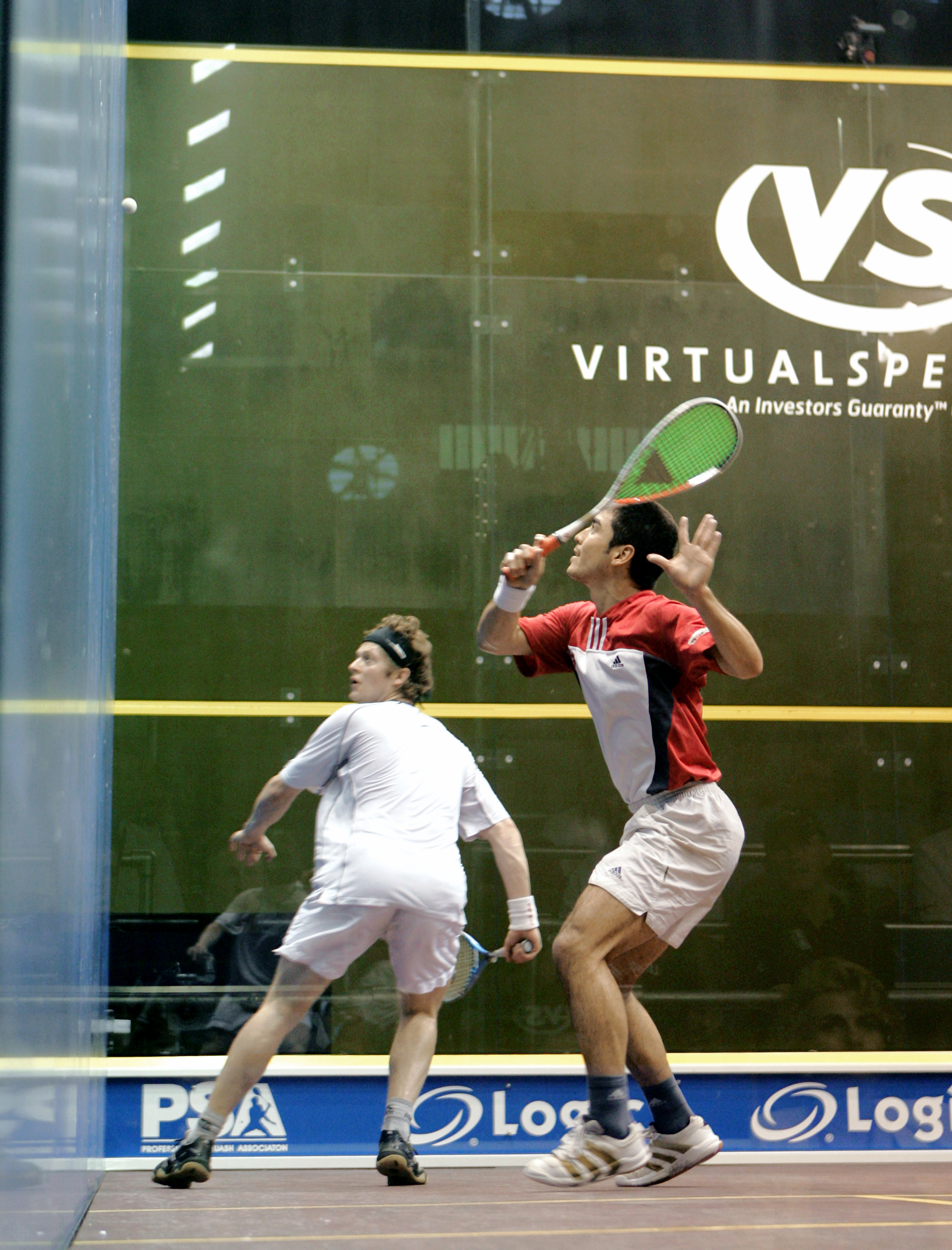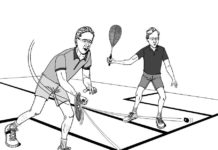By Barry Faguy, WSF Referees and Rules Committee
You’ve seen it a million times. The non-striker, having just hit the ball, now moves across from the side towards center, crossing either the ball’s return path from the front wall, or what would be the ball’s return path to the front wall. The striker, positioned further back in the court, refrains from hitting the ball and asks for a Let. This appeal can occur at an infinite number of places in either of the trajectories—and indeed, you can be sure you’ll be called upon to make decisions at all of these points. We commonly refer to those interference situations as ‘crossing the- flight-of-the-ball’. For this article, we will limit ourselves to those situations that might be called ‘direct’—meaning direct from front wall to striker, and directly back. The issue of side walls and back wall are not a consideration here—because we’ve dealt with them in previous articles.
THE CONSIDERATIONS

There are a few questions that need answering before we can get to the decisions:
What kind of interference?
Only two of the four forms of interference usually apply for CTF scenarios:
1. Fair View: This kind of interference, referred to in the first part of the 2nd sentence above, applies when the non-striker momentarily hides the ball as it is returning from the front wall and is still in front of that player. Having lost sight of it early, the striker will often call ‘Let’ while the ball is a relatively long way away from actually being hittable. Given the rule on ‘minimal interference’ (see previous articles), a player is playing with fire to claim ‘fair view’ interference in CTF situations because it is most often very momentary— often a fraction of a second. The striker is expected to put up with that.
2. Path of the ball to the front wall: This form of interference is the much more common reason for calling a Let. By definition, the ball is now further back and behind the non-striker—and the issue at hand is the possibility of the ball (if struck directly towards the front wall) hitting that non-striker who might be in the so-called ‘danger zone’.
What about the timing of the call?
This consideration is crucial. The concept of timing refers to both the moment the incoming striker says ‘Let’ (if it’s actually spoken), and the moment where the ball would actually have been hit. Sometimes a player appeals much before a ball is ‘hittable’— much too forward, or much too high.
In terms of when the ball was hittable, we know that the call of ‘Let’ stops play—and so both players stop moving. The further back the ball would have been hit, the larger is the danger zone in which the non-striker (who has now stopped moving) can be found, thereby tending to increase the likelihood of a stroke. On the other hand, if the non-striker has continued moving away, and there is still a delay before the ball is hittable, these then tend to decrease the likelihood of a stroke. Of course, all of this happens in a moment’s time. Nobody said this was easy!
What about reasonable fear of injury’ (RFOI)?
This is a significant consideration because it’s very common. The RFOI rule is specific to those situations where there is no interference to the travel of the ball directly to the front wall, but there is legitimate risk of injury. Of course, we have to keep in mind that sometimes there is neither— no interference and no RFOI. In these cases, the incoming striker simply wants to stop play for other reasons—perhaps stroke hunting, fatigue, a too-difficult return, etc.
What about the opponent’s clearing effort?
This is an interesting aside for CTF situations, but a moot point. Generally of course, when it comes to interference, this is a crucial question that you as a Referee need to consider. But we have no need for it here—the reason being that since we are talking about potential travel of the ball to the front wall, either the non-striker is in the way…or not. It just doesn’t matter whether the non-striker made every effort to clear.
What about Referee uncertainty?
Finally, we should mention this concept of uncertainty (also a previous article) that you should judiciously apply. It’s meant to be used (and a Let played) when you are unable to decide an appeal when faced with many of the complexities of an interference situation. To add to the complexity, very often the players simply stop play without uttering a word—then look at you, expecting that you will choose the circumstances that best suit their purposes. Claiming uncertainty is a valid explanation on occasion, but reverting to it too frequently will surely cause the players to wonder about your competence.
THE DECISIONS
So, here are the bottom line suggestions for these scenarios:
NO LET—if the interference is insignificant or occurs much too early.
NO LET—if there is no interference, nor any RFOI.
YES LET—if there is no interference, but there is RFOI.
YES LET—if you are uncertain as to any element.
STROKE—if the opponent is in the danger zone when the ball was playable by the striker





